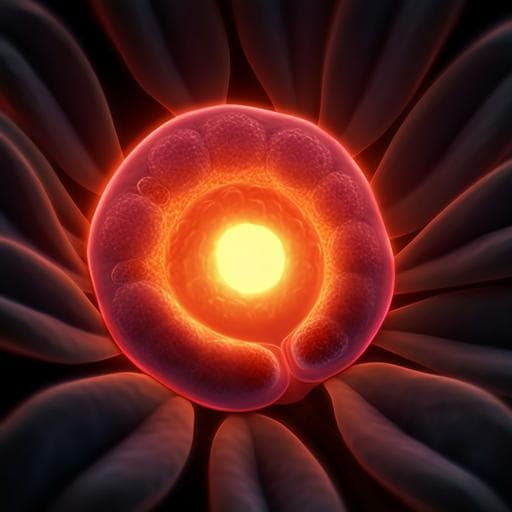
Biology
Mechanism of fertilization-induced auxin synthesis in the endosperm for seed and fruit development
L. Guo, X. Luo, et al.
Discover the critical role of the type I MADS box gene *AGL62* in activating auxin synthesis in the endosperm, a pivotal mechanism that aids the successful development of maternal tissues in flowering plants. This groundbreaking research was conducted by Lei Guo, Xi Luo, Muzi Li, Dirk Joldersma, Madison Plunkert, and Zhongchi Liu.
~3 min • Beginner • English
Introduction
Fruit and seedcoat development in angiosperms is initiated by fertilization, yet the molecular trigger linking fertilization to maternal tissue differentiation is unclear. Prior work in strawberry established that auxin produced by seeds induces receptacle fruit growth, and studies in Arabidopsis and tomato support a conserved auxin-dependent mechanism for fruit set. Transcript profiling in Fragaria vesca indicated that auxin biosynthesis genes (YUCs and TAAs) are induced in the endosperm immediately after fertilization, implicating the endosperm as the fertilization sensor that produces auxin for both seed and fruit development. Endosperm development starts as a syncytium and later cellularizes; auxin levels influence this timing and thus seed size. In Arabidopsis, the type I MADS-box gene AGL62 prevents premature cellularization, but its relationship to auxin biosynthesis was unresolved. This study asks whether AGL62 activates auxin synthesis in the endosperm and by what mechanism, using F. vesca and Arabidopsis to test conservation and functional relationships.
Literature Review
- Auxin from seeds induces fruit development in strawberry; exogenous auxin can substitute for achenes to enlarge receptacle fruits.
- Genetic data in Arabidopsis and tomato show auxin signaling mutants can form parthenocarpic fruits, highlighting conserved auxin roles in fruit set.
- In Arabidopsis, expressing auxin biosynthesis genes in the central cell induces autonomous endosperm proliferation, seedcoat differentiation, and fruit development, identifying the endosperm as a fertilization sensor and auxin source.
- Auxin levels in endosperm control nuclear proliferation and cellularization timing; excessive auxin prevents cellularization, while reduced auxin restores it.
- AtAGL62 is expressed in proliferating endosperm and prevents premature cellularization; prior work linked AtAGL62 to auxin transport (e.g., ABCB/PGP10) from endosperm to seedcoat but did not explain auxin biosynthesis regulation.
These studies frame the hypothesis that AGL62 may regulate auxin synthesis, not just transport, in the endosperm.
Methodology
- Species and growth: Fragaria vesca (diploid, YW5AF7 line) grown under controlled conditions; Arabidopsis thaliana Col-0 and atagl62-2 T-DNA line used. Reporter lines included DR5ver2::GUS in F. vesca, and R2D2 and ProAtYUC10::3xnGFP in Arabidopsis.
- Gene identification and reporters: Co-expression network mining from F. vesca floral/fruit transcriptomes identified candidate transcription factors enriched in stage 2 seeds. Phylogenetic analyses classified FvH4_2g03030 as FveAGL62 and FvH4_6g08460 as FveAGL80. Promoter–GUS fusions (ProFveAGL62::FveAGL62-GUS, ProFveAGL80::FveAGL80-GUS) were generated to verify endosperm-specific, post-fertilization expression.
- Genome editing: CRISPR/Cas9 knockouts of FveAGL62 (two sgRNAs) and FveAGL80 (one sgRNA) were created; multiple independent lines were genotyped for frameshift mutations.
- Crosses and imprinting tests: Reciprocal crosses between fveagl62 and WT assessed parental effects; ProFveAGL62::FveAGL62-GUS crossed reciprocally with WT to assess imprinting of expression.
- Hormone treatments: Fertilized fveagl62 receptacles treated with GA3, NAA, or both; fveagl62 seeds treated with NAA; Arabidopsis atagl62-2 heterozygous siliques treated with 2,4-D.
- RNA-seq: Stage 2 F. vesca seeds (∼50 seeds per replicate; n=3 biological per genotype) from WT and fveagl62 were profiled (Illumina PE150; Salmon quantification; DESeq2 for DEGs). GO enrichment via OmicsBox/TopGO.
- Reporter assays for auxin: DR5ver2::GUS in F. vesca; in Arabidopsis R2D2 (DII-VENUS/mDII-Tdtomato ratio) and ProAtYUC10::3xnGFP to monitor YUC10 expression in endosperm.
- Microscopy: Confocal laser scanning microscopy on clarified seeds to assess endosperm syncytial state vs. cellularization; seedcoat staining by vanillin for proanthocyanidins in strawberry and Arabidopsis.
- Protein–protein and protein–DNA interactions: Y2H and BiFC tested FveAGL62/80 interactions. Yeast one-hybrid (Y1H) screened/binding to promoters (FveYUC10, FveTAR1, FveATHB29b, FveATHB30). Transient tobacco luciferase assays quantified promoter regulation by FveAGL62/80 and FveATHBs.
- Transgenics: Overexpression (UBQ10 promoter) of FveATHB29b and FveATHB30 in F. vesca; phenotyping of fruit size and seed endosperm; RT-qPCR of auxin biosynthesis genes in stage 2 seeds. Arabidopsis complementation with ProAtAGL62::FveAGL62:terAtAGL62 in atagl62-2 background.
Key Findings
- FveAGL62 and FveAGL80 are specifically induced in endosperm post-fertilization (stage 2), not in pre-fertilization ovules.
- CRISPR loss of FveAGL62 causes seed arrest and failure of receptacle fruit development beyond stage 2; vegetative growth remains normal. Reciprocal crosses showed no imprinting; defects occur only when both parents are mutant.
- Exogenous GA3 and NAA partially enlarge fveagl62 fruits and seeds; combined treatment strongest, but seeds remain non-viable, suggesting additional defects besides hormone shortage.
- RNA-seq of stage 2 seeds: 1102 genes down-regulated and 1572 up-regulated in fveagl62 vs WT. Auxin biosynthesis genes (FveYUC1/5/10/11, FveTAA1, FveTAR1/2) and GA biosynthesis genes (e.g., FveGA20OX1c/1d, FveGA3OX1a/1b) are significantly reduced. RT-qPCR confirmed reductions in five auxin biosynthesis genes. Temporal profiles in WT show increasing auxin/GA biosynthesis transcripts from stage 1 to stage 3.
- Auxin activity reporters: DR5ver2::GUS signal is greatly reduced in fveagl62 endosperm at stage 2, with residual pattern strongest at chalazal end.
- Endosperm phenotype: fveagl62 seeds display premature endosperm cellularization at stage 2; confirmed in multiple independent lines and in heterozygous lines where 25.9% of selfed F1 seeds showed early cellularization (n=54). NAA treatment at 1 DPA rescued premature cellularization in 11.9% (n=42) of fveagl62 seeds vs 0% in mock (n=56).
- Arabidopsis conservation: atagl62-2 endosperm shows elevated DII-VENUS (higher DII/mDII ratios), indicating reduced auxin. ProAtYUC10::3xnGFP is strong in WT (95.4% of seeds, n=121) but undetectable/weak in 92.86% of atagl62-2 seeds (n=56), showing reduced YUC10 expression. 2,4-D treatment reduces proportion of completely cellularized seeds from 22.7% (n=608; ≈91% of the expected homozygotes) to 15% (n=633; ≈60% of homozygotes), indicating partial rescue. ProAtAGL62::FveAGL62 fully rescues atagl62-2 defects, including endosperm cellularization and seedcoat.
- Seedcoat: Unlike Arabidopsis, strawberry fveagl62 seedcoats accumulate proanthocyanidins normally and display normal integument layers, indicating seedcoat development in strawberry is FveAGL62-independent.
- Downstream module: Several FveATHB genes (notably FveATHB29a/29b/30) are up-regulated in fveagl62 seeds and decrease from stage 1 to 3 in WT. Y1H and transient assays show FveAGL62/FveAGL80 together activate in yeast but repress in planta the promoters of FveATHB29b and FveATHB30, consistent with direct repression. FveATHB29b and FveATHB30 bind the FveYUC10 promoter (Y1H); FveATHB30 represses ProFveYUC10::LUC in tobacco.
- Overexpression of FveATHB29b or FveATHB30 in strawberry reduces fruit size; NAA application restores fruit size. Stage 2 seeds from OE lines show 2–10-fold reductions in FveYUC10 and FveTAA1 transcripts and exhibit extensive endosperm cell death and occasional precocious cellularization (∼8.5%).
- Model: Upon fertilization, FveAGL62/FveAGL80 heterodimers repress FveATHB29b/30, lifting repression on auxin biosynthetic genes (e.g., FveYUC10), increasing auxin production in endosperm which is then transported to maternal tissues to stimulate fruit development.
Discussion
The study demonstrates that AGL62 is a conserved, positive regulator of auxin biosynthesis in the sexual endosperm of strawberry and Arabidopsis. Loss of AGL62 reduces auxin biosynthetic gene expression and auxin accumulation, correlating with premature endosperm cellularization and failed fruit/seed development. Partial rescue by exogenous auxin in both species supports auxin acting downstream of AGL62 in this context. Mechanistically, AGL62 (with AGL80) indirectly promotes auxin biosynthesis by directly repressing specific ATHB transcription factors (FveATHB29b/30) that bind and repress auxin biosynthetic promoters (e.g., FveYUC10). Overexpression of FveATHBs phenocopies aspects of fveagl62, including reduced auxin biosynthesis gene expression, smaller fruits, and defective endosperm, further validating this regulatory axis. The findings address the longstanding question of how fertilization triggers auxin production in endosperm to coordinate seedcoat and fruit development, linking fertilization-induced AGL62 expression to a derepression cascade enabling auxin synthesis and subsequent transport to maternal tissues. Differences between species in seedcoat dependence on AGL62 likely reflect divergent reproductive structures or auxin source tissues, but the core AGL62–ATHB–auxin module appears conserved.
Conclusion
This work establishes AGL62 as a key mediator of fertilization-induced auxin synthesis in the endosperm across strawberry and Arabidopsis. FveAGL62/FveAGL80 repress FveATHB29b/30, relieving repression of auxin biosynthetic genes to drive auxin accumulation, which supports endosperm proliferation and stimulates maternal tissue development, including fruit growth. The results unify genetic and physiological observations by providing a mechanistic link between fertilization and auxin production. Practical implications include strategies to modulate seed size, fruit set, and parthenocarpy by targeting the AGL62–ATHB–auxin pathway. Future research should elucidate upstream signals that induce AGL62/AGL80 post-fertilization, define the full complement of ATHB targets and interacting partners, clarify species-specific auxin transport routes to maternal tissues, and explore feedback loops between auxin levels and AGL62 expression.
Limitations
- Hormone treatments only partially rescued endosperm defects and did not restore seed viability in fveagl62, indicating additional AGL62-dependent processes (e.g., GA biosynthesis, auxin transport) are involved.
- Reporter discrepancies exist between studies concerning auxin accumulation in Arabidopsis atagl62 endosperm (DR5 vs R2D2/ProYUC10 reporters), suggesting reporter- or stage-specific sensitivities.
- The initial upstream cue(s) by which fertilization induces AGL62/AGL80 expression remain unknown.
- Functional redundancy among FveAGL80-like genes may mask phenotypes (no phenotype in fveagl80 single mutant).
- Overexpression analyses (UBQ10 promoter) affect multiple tissues/times and may induce non-physiological effects (e.g., endosperm cell death), complicating direct comparison to loss-of-function of AGL62.
- While indirect regulation of auxin biosynthesis via ATHBs is supported, direct in vivo binding sites, chromatin states, and comprehensive target networks warrant further validation.
Related Publications
Explore these studies to deepen your understanding of the subject.







